Sambhal of Uttar Pradesh is burning and a mosque is at the center of the controversy. As soon as the order for survey of the 16th century Jama Masjid in Sambhal of Moradabad came, the flames of anger ignited inside the local people there. What happened after this became the headlines of every newspaper, media channel.
In fact, recently when the team of the court commissioner reached at 7 o’clock for survey on the basis of the suit filed calling the Jama Masjid of Sambhal as Harihar temple, there was a riot in Sambhal. Suddenly on the information of the team’s arrival, the crowd gathered and started trying to enter the mosque. When stopped, they pelted stones at the police. The violent crowd vandalized several vehicles including the car of Chandausi CO and set them on fire. Meanwhile, firing also started. The police dispersed the crowd by firing tear gas shells and lathicharge. Five people died after getting caught in the riot. In this fire of anger, police officers were injured, many died and normal life was disrupted after the riots, but what is the history of the mosque about which so much ruckus has been created?

From Europe to Arab or Asia, who knows how many such places are there today, which have evidence that mosques were built by breaking the religious or cultural heritage of other faiths. The mosque of Turkey was converted into Hagia Sophia Church, about seven hundred churches of Spain were demolished to build mosques. Even today, who knows how many Jain temples, Gurudwaras, Hindu temples were demolished in Pakistan, they cannot even be counted.

A similar controversy was seen in Sambhal, but this is not a new controversy. Actually, the truth had started to be revealed decades ago, when the book “The Religious Policy of Mughal Emperors” was published in 1940. In Hindi it can be said as “Mughal Samraton ki Dharmik Niti”. In this book, the nature of Mughal rule in India was described in different ways by Prof. Shri Ram Sharma ji, who was a professor of history, political science and public administration at Punjab, Bombay and Poona universities for many years, was a member of the Indian Historical Records Commission and a Fellow of the Royal Historical Society, and was also the Director of the Institute of Public Administration, Chandigarh and Principal of DAV College. His “The Religious Policy of Mughal Emperors” was published in several volumes in different years.

From this came the history of the Shahi Masjid of Sambhal, because after Prithvi Raj Chauhan went to Delhi, both the brothers Alha and Udal were the main protectors of this place. It is said that Udal hung a millstone on a wall in a single jump. Today’s generation may not be familiar with Alha and Udal, but the tale of their bravery is still sung in the rural areas of Hindi speaking areas.
Later came the medieval period, the strategic importance of Sambhal increased, because it is close to Agra and Delhi. By the time Babar came, the estate of Sambhal was in the hands of Afghan chieftains. Babur gave Humayun the estate of Sambhal, but he fell ill there and was brought to Agra. Thus, after Babur, Humayun divided the empire among his brothers and Sambhal was given to Babur’s youngest and fourth son Askari.

But Sher Shah Suri drove out the Askaris and gave the jagir of Sambhal to his son-in-law Mubariz Khan. Later Sambhal was recaptured, Humayun was made the governor of Sambhal and Humayun handed over the rule to his son Akbar. But it was during Babur’s reign that the Harihar temple, which was the center of worship of Hindus there, was converted into a mosque by Babur in 1529 and named Shahi Jama Masjid.
On Babur’s orders, Mir Baqi, a Mughal general and a trusted court member who served both Babur and Humayun, was entrusted with the task of building a mosque by demolishing the temple on Babur’s orders and destroyed the temple. Later it has been repaired and improved by many rulers over the years. An inscription in the southern wing states that Rustam Khan Dakhani repaired the mosque in 1657. A similar plaque in the northern wing was erected by Syed Qutb in 1626. Two inscriptions on the outer and inner arches of the central chamber record the renovations carried out around 1845 by Muslims of the city and district.
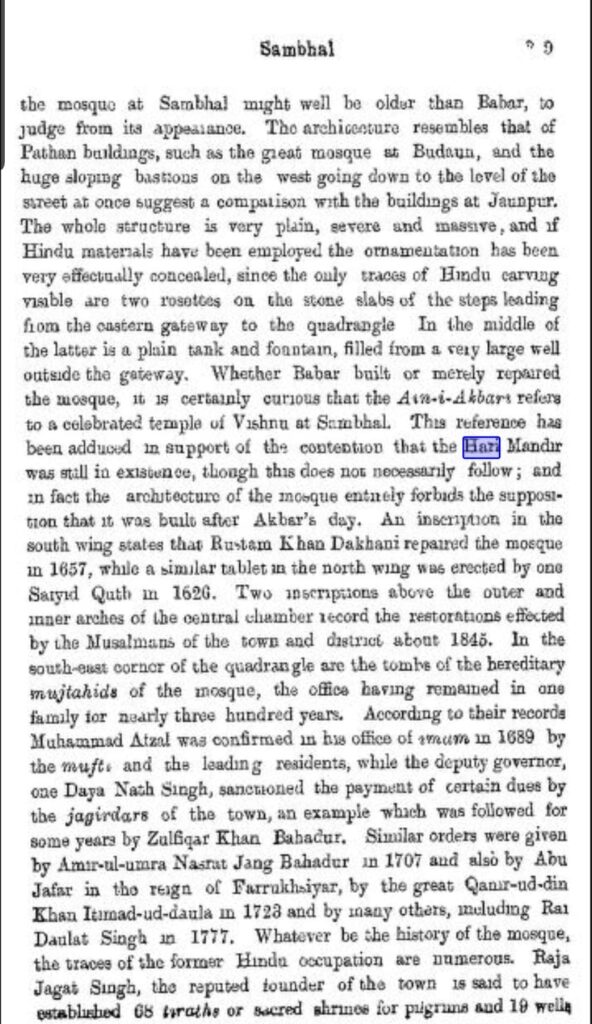
In the year 1940 and even after that, Shri Ram Sharma is one of those scholars who in his book “The Religious Policy of Mughal Emperors” (1963 AD) levelled allegations against Babar and brought forth the matter of demolishing a temple to build a mosque. In the book “The Religious Policy of Mughal Emperors” its history and the demolition of the Mughals have been put forth. Shri Ram Sharma ji collected evidence from the Indian archives and brought out the truth on the pages. He gave evidence of the mention of a famous temple of Vishnu in Sambhal recorded in “Ain-e-Akbari” and asked, where did that temple go? This reference is given in support of the argument that Hari Mandir existed till then, where did it go later?
The controversy started when advocate Vishnu Shankar Jain and others filed a petition in Sambhal. Jain, known for his involvement in the Gyanvapi mosque and Krishna Janmabhoomi controversies, claimed that the Jama Masjid was built on the ruins of a temple dedicated to Lord Kalki. The petition alleges that the mosque was built after the temple was destroyed during Babur’s invasion in 1526-27. The petitioners argue that historical texts such as the Baburnama and Akbarnama document the destruction of the temple on Babur’s part.
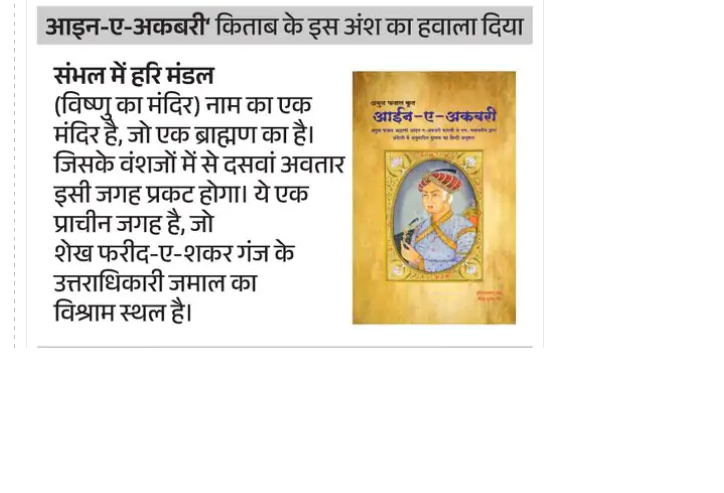
The plea claims that the temple was built by the Hindu mythological figure Vishwakarma at the beginning of the universe. It is alleged that Babur’s army partially destroyed the temple and converted it into a mosque to establish Islamic supremacy. The petition further criticises the Archaeological Survey of India for failing to take control of the site, as it is a protected monument under the Ancient Monuments and Archaeological Sites and Remains Act of 1958. The petitioners are demanding unrestricted access to the mosque for Hindus, claiming that their right to worship is being illegally denied. Vishnu Shankar Jain said that this is an ASI protected area. There are many signs and symbols here, which indicate that there was a temple here. If we understand the matter, then from CAA protests onwards, Muslim leaders talk about running the country by constitution. They raise slogans with a copy of the constitution in their hand but when the court passes an order according to this constitution, they create a ruckus by not following it. Whether it is the case of triple talaq or the CAA’s case against the Waqf Board or the law regarding the marriage of minor girls, everywhere they beat the drum of Shariat and then say that the country should be run by the constitution.
Secondly, regarding the Jama Masjid in Sambhal, Uttar Pradesh, many scholars, maulanas and Muslim leaders are saying that the mosque was not built by demolishing a temple. Okay, let’s accept the point, but when a survey is to be done, then what is there to fear? If the mosque was not built by demolishing a temple, then should one take the initiative and get the survey done?
BY-Rajeev Choudhary



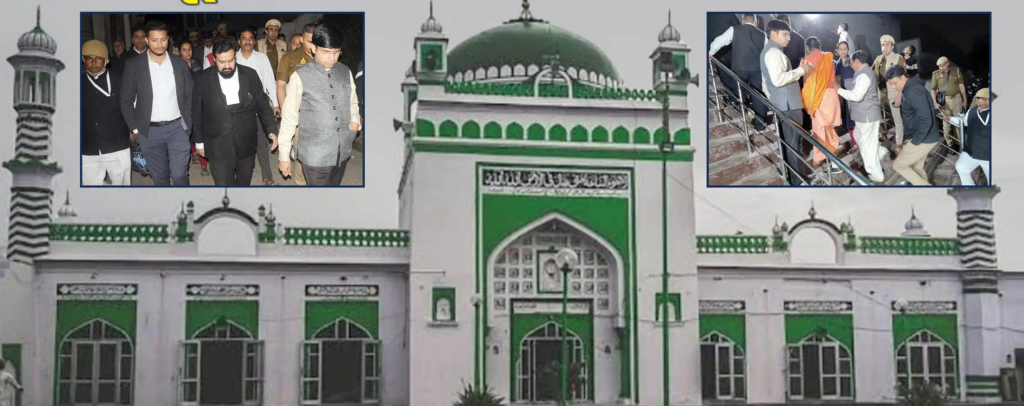
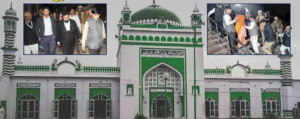
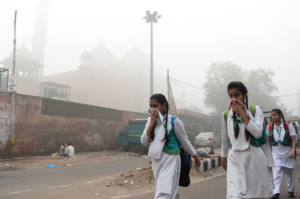
More Stories
How did the Upanishads reach Europe from India?
Who is the real king of Middle East Gulf countries?
Hyderabad Movement when Arya Samajis came out against Nizam